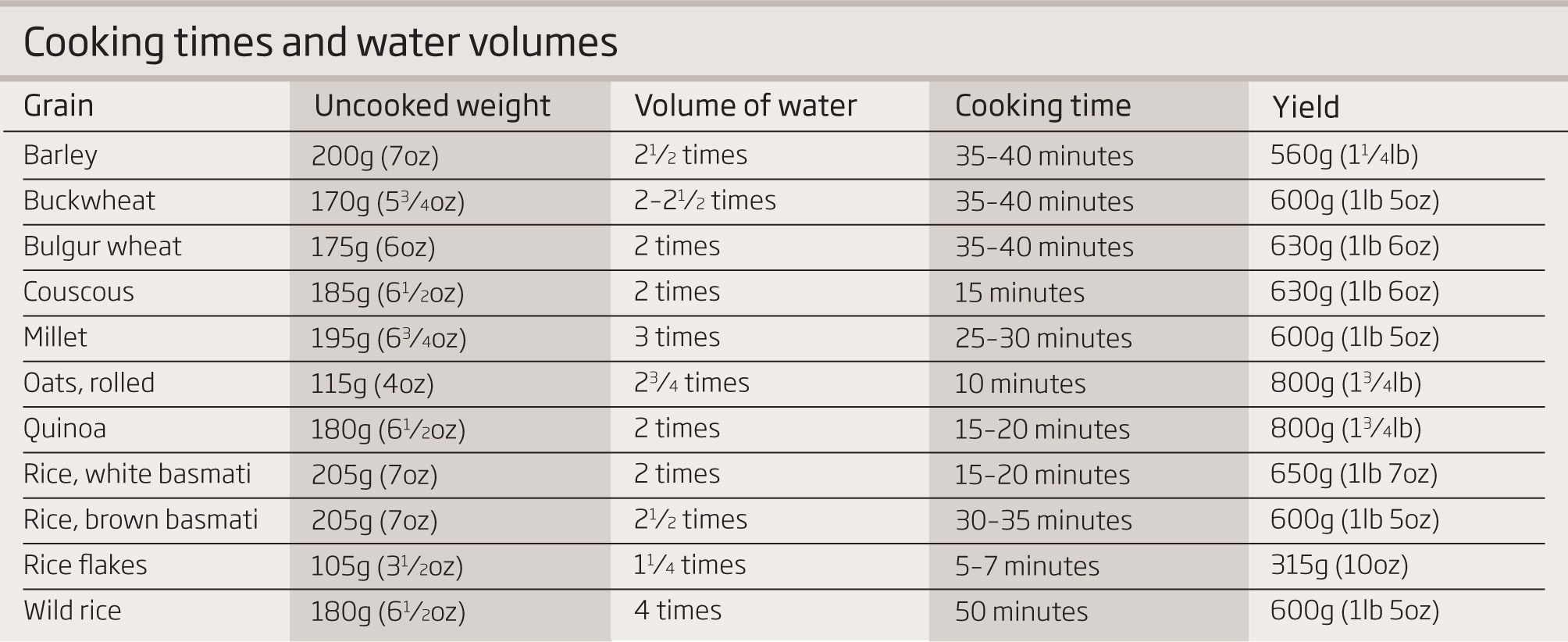Cooking techniques
Grains and legumes are key to a lacto-vegetarian diet, but people often find them hard to digest. It is important to know how to cook them properly to avoid bloating, gas, or indigestion. Washing and soaking before cooking removes dirt and makes them more digestible. Oils are used in a lacto-vegetarian diet to replace animal fats. Knowing how to store oils correctly to prevent them from turning rancid is essential.
Grains
The key to cooking grains is to measure or weigh them so you know how much water to use. The table below shows you the correct proportion of grains to liquid to produce about 31⁄2 times the volume of the dried grains.
SOAKING AND RINSING Most grains, except for quinoa and millet, will be more digestible if you soak them in cold water before cooking for at least 30 minutes or preferably overnight. Quinoa and millet may be dry-roasted for a few minutes instead. Whether or not you have soaked them first, before cooking rinse the grains in cold water 2–3 times, ideally until the water runs clear.
COOKING Bring the correct amount of water to the boil (see chart), add the grain, and a pinch of salt. Bring back to the boil, reduce the heat, and cover. Simmer until the water has been absorbed. Remove from the heat but leave for a few minutes in the covered pan before serving to dry out the grains.

Legumes
Many people have problems digesting beans and pulses. They can cause flatulence and allergies. If you are just starting to add beans to your diet, eat them no more than 1–2 times a week for the first few weeks. After that you may be able to increase your consumption to 3–4 times per week. The most easily digested beans are split mung beans, aduki (adzuki), and black gram beans (urad dal). Following the guidelines below will make beans easier to digest:
SOAKING AND RINSING Always soak beans before cooking. This helps remove the oligosaccharides (a form of carbohydrate) that cause flatulence. Soak for 4 hours or overnight in 3–4 times their volume of water. Soak fava beans and older beans for 24 hours. Rinse before cooking.
COOKING Cook in fresh water. You may need as much as 6 times their volume of water, as some of the water evaporates during cooking. Bring to the boil, partially cover, and simmer until soft. Never eat undercooked beans and do not boil them or add salt or acid ingredients, such as large amounts of lemon juice or tomatoes. This can make them tough and hard to digest.
SERVING Adding ginger, fennel, cumin, or black pepper to cooked beans aids digestion. Traditionally, these spices are sautéed in ghee (clarified butter) or oil, then added to the finished dish.
Oils
Research shows that trans fats contribute more than unsaturated fats to cardiovascular disease. Trans fats are formed when oils are exposed to heat and air, so it is vital to know how to store oils and which to use for cooking.
STORING Always store oils in a dark place and choose oils that are packaged in dark glass or metal containers. Avoid those that are sold in clear plastic bottles. Stable oils – those that are not damaged when exposed to high temperatures, such as ghee and olive oil – can be stored in a dark cupboard. Cold-pressed oils, such as avocado, flaxseed, safflower, and sunflower oils, are very unstable and should be kept in the refrigerator.
COOKING For cooking at high temperatures, especially above 160°C/325°F/Gas 3 as when baking in the oven, only use the most stable oils. Choose from organic ghee, organic sesame oil, palm kernel oil, or coconut oil. You can sauté food at moderate temperatures using olive oil. Never use the unstable, cold-pressed oils mentioned above for cooking.